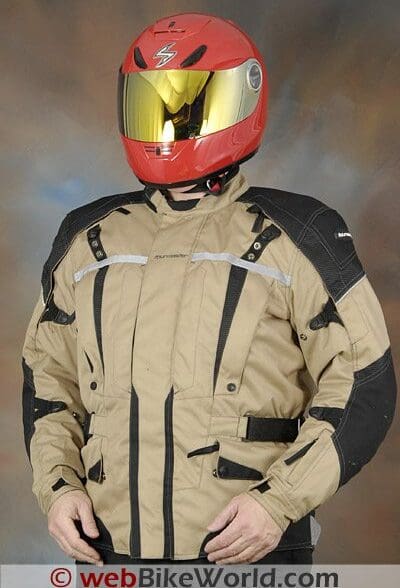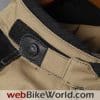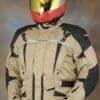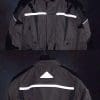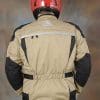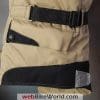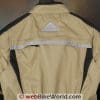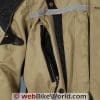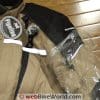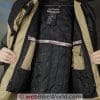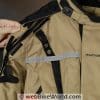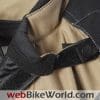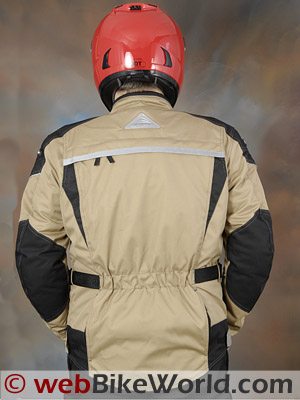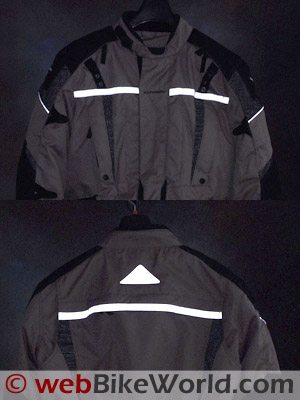The Tourmaster Transition Series 2 is an excellent all-around, medium-weight 3/4-length jacket.
It will work in the majority of riding conditions that anyone but a hard-core Adventure Touring rider might encounter.
These multi-part reviews aren’t easy!
It’s difficult enough to run the full webBikeWorld detailed evaluation on one product, a process that can take several weeks plus anywhere from 8-20 hours at the keyboard and behind the lens.
But doing it for three jackets and then trying to compare and contrast the differences is about 3×3=9 times harder!
Not to mention that the Tourmaster Transition Series 2 jacket shown here is similar to the Rev’it Dragon (review) and the Tourmaster Epic jacket only in that it has sleeves and a liner and it’s called a jacket.
While they all appear to be standard 3/4-length jackets, in reality they are very different.
As we mentioned in Part 1 of this series (the Rev’it Dragon jacket), there’s no “best” here. Any one of these jackets would serve admirably — it’s a matter of matching your criteria (and budget) to one of the products.
We’ve been swapping all three jackets back and forth over the last couple of months now; a duration that has spanned one of the nastiest Mid-Atlantic winters on record to…one of the coldest Spring seasons on record. And wet too.
Slowly but surely, the weather is breaking — indeed, this weekend is supposed to bring sunny temperatures in the mid 80’s! I’ll believe it when I see it, but it’s typical around here that we’ll go from cold and damp to hot and humid overnight. Soon we’ll be breaking out the mesh.
But in the meantime, the Tourmaster Transition Series 2 is a perfect jacket for Spring 2009, in more ways than one. It’s what we might call a light-weight or mid-weight 3/4-length jacket without the heavy and protective insulation of something like the Rev’it Cayenne Pro or the Tourmaster Epic jacket that we’ll be reviewing next in this series.
But the Tourmaster Transition Series 2 has another thing going for it that makes it attractive this particular Spring: its price.
Tourmaster is probably, well, the master at the cost/value equation. The Transition Series 2 has a list price of $189.99 and a street price of around $170.00. This makes it a real bargain, and other than a few minor quality problems with stitching, the Transition Series 2 is an excellent buy.
Tourmaster has always been an underdog favorite around here. The brand is characterized by nicely styled, non-radical clothing that incorporates the basic features that most riders demand, all at a price point that just about anyone can afford.
The Tourmaster Cortech over-pants I reviewed many years ago are still on my go-to clothes rack; I haven’t found a pair yet that can beat their price/performance ratio and they’re one of the most useful motorcycle clothing items I’ve ever owned. That’s quite an endorsement when you consider how many different types of motorcycle clothing flow through here each year.
The Tourmaster Transition Series 2 appears to be a close cousin to another long-time favorite, theTourmaster Advanced jacket reviewed on these pages in October of 2005. That was the last Tourmaster jacket we reviewed, and it sold for $269.99 in 2005 dollars.
Here it is in 2009 and we have the Transition Series 2 with more features, probably better looks and it’s 100 bucks cheaper. Isn’t progress great?!
Just realize though when comparing the overall quality between the Tourmaster and the Rev’it Dragon, the Tourmaster does come up a bit short. Quality is sometimes a tough word to define, and here’s a good example: The fabrics used in the Transition Series 2 are not equivalent to Rev’it standards, although it is probable that only an experienced eye might tell the difference.
But the quality and execution of the stitching used in the Tourmaster could definitely use some improvement; a few of the stitch lines are uneven; some run off the edge of the material, and there are hanging threads here and there. Nothing major, mind you, but just realize that we’re not saying that you’re paying less for the same quality. Expectations need to be normalized to the reality of the price.
Let’s take a look…
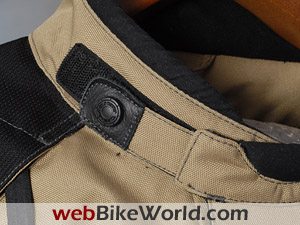
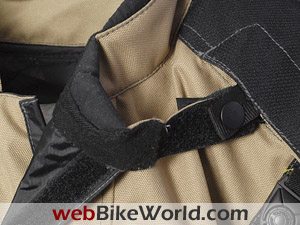
Jacket Weight, Heft and Sizing
The Tourmaster Transition Series 2 jacket at 2.5 kg (5.5 lbs.) is .4 kg lighter than the Rev’it Dragon (2.1 kg or 4.75 lbs.), but as we mentioned in the Rev’it Dragon review, the Transition Series 2 somehow feels lightest of the trio.
It is more of a three-season jacket than the other two; the insulation feels a bit lighter and when the temperature gets down to about 50 F (10 C) or so, I find that a turtleneck and a windproof vest like the Rev’it Scoop windproof vest (review) is necessary to stay warm.
Note that one important difference is that the Tourmaster Transition Series 2 does not have a separate removable wind- and water-proof liner. I’ll address this in the “Liner and Lining” section below.
The jacket shown here is a men’s size large and it fits exactly as expected; slightly snug for a 43″ chest and 33″ to 34″ sleeve length with the liners and it loosens up about 1/2 size larger with the liners removed. One side benefit of the slightly thinner insulating liner is there’s less size difference with the liner removed.
This can be a problem with jackets having thicker insulation, but insulation technology is forever advancing, giving us thinner liners with more comfort than ever.
Besides scale weight, there’s another sort of weight to consider — the feel of the jacket. The insulation used in the Transition Series 2 feels lighter in the chest as the other jackets, but again, this will be a plus for owners living in more temperate climes.
So our feeling is that the Transition Series 2 is biased more towards Spring/Summer/Fall riding, and it may just prove to be one of the better hot weather 3/4-length jackets, especially with its ample ventilation.
The shell is made from a 600 denier “Carbolex” and “Ballistic Polyester” fabric.
The Transition Series 2 is available in a very good expanded size range of men’s sizes from XS all the way up to 4XL in regular lengths and M to 3XL in Tall sizes. It’s also available in women’s sizes from XS to XL, but we’re not sure if the women’s sizes are shaped or styled differently.
Transition Series 2 Details
I’ll try to follow the format we initiated with the review of the Rev’it Dragon by starting the descriptions of all three jackets outside top, then work down to the bottom, then do the same for the inside. This standardization will hopefully allow some comparison between the trio.
Neck and Collar
The neck of the Transition Series 2 is a basic affair, with a raised collar that’s lined on the inside with a thinly padded top of softer material. The collar has a small padded round shaped section at the front with softer material to help prevent chafing.
The collar attaches with a simple hook-and-loop section up on the right-hand side, which also provides a small range of adjustment.
One interesting feature is the addition of a snap, with a matching snap on the left that is attached to the left-hand shoulder vent. The collar can be held open using the snap to allow ventilation at the throat.
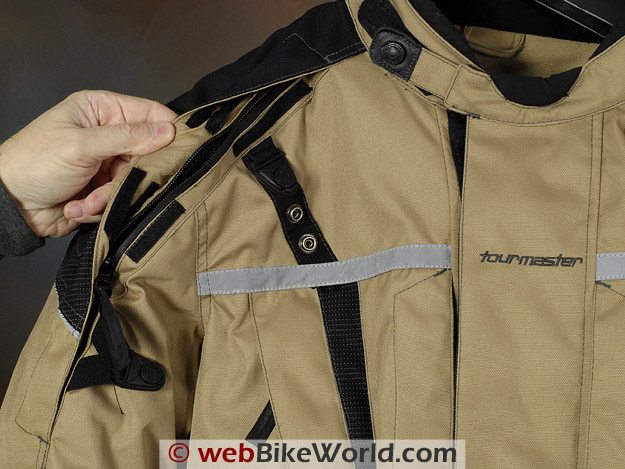
Zippers, Closures and Adjusters
Zippers
The full-length front zipper on the jacket shell is unlabeled but has a large Tourmaster zipper pull. The jacket has a single front zipper with large nylon or plastic teeth, and one folding placket that covers the zipper in front.
This may be one of the reasons why the Tourmaster Transition Series 2 doesn’t have the same low-temperature comfort as either the Rev’it Dragon, with its multiple layers and windproof liner, or the Tourmaster Epic jacket, which has a much thicker insulating liner and what feels like a thicker outer shell and attached lining.
One added feature on Transition Series 2 is the dual-pull on the zipper; it can open up or down and opening it up from the bottom allows the jacket to spread at the bottom and comes in handy when putting on boots. This is one of the features that adds to the Enduro theme of this jacket.
Sleeve Cuffs
The cuffs seal with a simple hook-and-loop attachment system, similar to that used on the Rev’it Dragon and many other motorcycle jackets. It’s simple and it works and leaves a narrow profile at the cuff that helps the sleeve fit into just about any glove gauntlet.
The inside of the cuffs are lined with a thin but soft corduroy, a nice touch. This adds a bit of comfort to the sleeve cuff where it rubs against the rider’s wrist.
Adjusters
The Transition Series 2 features a wide adjustment strap at both sides at the waist under the arms. The band has a friction D-ring style system for adjustment. The bands are attached to the jacket at the back and they have a discrete “Tourmaster” logo embossed in the material; you have to look pretty closely to actually see it as raised portions of the weave.
The adjuster bands are complimented by a piece of elastic material sewn into the jacket shell along the back at the same height.
The combination of the waist adjusters and the elastic allow the jacket to be cinched to keep cold air from blowing up from underneath.
The arms of the jacket each have two adjusters, one in the forearm and one at the bicep. These are hard rubber covered snaps with a total of three each metal snaps on the sleeve body. The extra snap gives a good range of adjustment.
An adjuster snap is located at the upper front part of the shoulder at the collarbone on either side. These can be used to hold down the material at the front of the jacket when the shoulder vents are open to allow more air to flow in to the “scoop” vent.
One more pair of adjusters, one on each side, are located at the bottom of the jacket at the hem. These are covered with reflective material and can serve to tighten up the jacket hem about 30 mm or so.
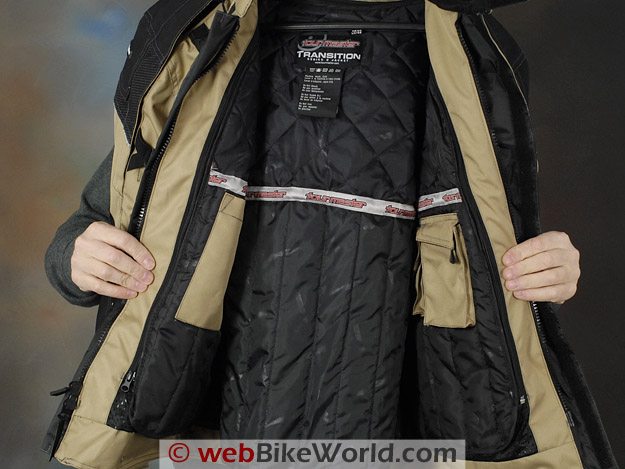
Windproof or Waterproof Liners and Jacket Lining
The only removable liner in the Transition Series 2 is the insulating liner; the jacket does not have a separate removable wind- or water-proof liner like the Rev’it Dragon. The Tourmaster Epic jacket also does not include a separate removable wind- and water-proof liner.
The absence of a separate removable wind/waterproof liner is somewhat of a Tourmaster tradition. Any water or wind resistance that the jacket does offer is taken care of by both the jacket shell and a liner that is permanently bonded to the inside of the shell.
In the original Tourmaster 3/4-length jackets of old, water resistance was provided by a basically impermeable membrane on the jacket shell, and the consensus was that those jackets were hot because they didn’t breathe.
Tourmaster now uses what it says is a waterproof and breathable “Rainguard” barrier that is apparently bonded to the jacket shell. I say “apparently” because I can’t tell if there is a separate liner or how it might be attached. Grommets that serve as drain holes are located in the jacket hem and cuffs, so Tourmaster must figure that the water will soak through the outer shell but will be stopped at the membrane where it will drain out the bottom.
Although the Transition Series 2 jacket definitely does not have the water-resisting capabilities of the Rev’it, with its proven Hydratex liner, the jacket does offer at least some basic protection from a light shower or two.
But with all those vents and seams, just don’t expect this jacket to be 100% waterproof. It’s not.
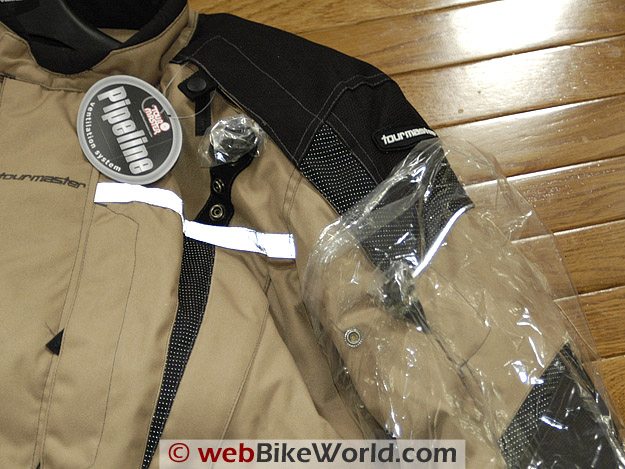
But the reverse is true; the Transition Series 2 is much more comfortable when the temperatures rise. Remove the liner and open all the vents and the jacket actually becomes a pretty nice warm/hot weather Enduro jacket.
Certainly not as cool as, say the Rev’it Sirocco, which without doubt has outstanding ventilation with its mesh panels, but the Transition Series 2 is probably as good as it gets in a non-mesh 3/4-length jacket.
Insulation
The insulating liner zips to the jacket with a single zipper up one side, around the neck and down the other side. It’s not a double zipper, so it opens from one side only.
The insulation continues down the sleeves and ends about 10 cm above the cuff, which helps to thin out the end of the sleeve and allows the jacket to slip nicely into a glove gauntlet.
Each sleeve has two snap attachments that fit over loops sewn into the inside of the sleeve to hold the ends of the sleeves in the jacket. The bottom of the liner at the lower section of the back also features two loops and snaps on the liner to hold it in place and to help prevent it from rising up the rider’s back.
Each loop is colored either white or black and matches the corresponding loop on the liner, which makes it easy to re-attach the liner and get the correct alignment.
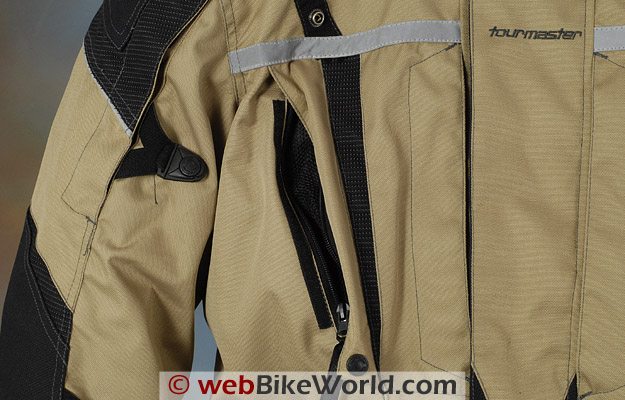
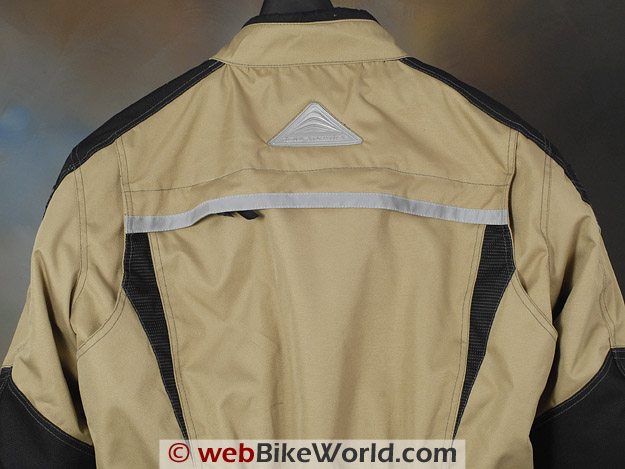
Ventilation and Air Flow
Venting is definitely a forte of the Transition Series 2 jacket, with several large vents that can be held open to allow air flo. The jacket features a very long 30 cm shoulder and upper arm vent on either side that opens with a (claimed) waterproof zipper. These vents can be held open by a separate section of hook-and-loop underneath, so they act as air scoops. We first experienced this type of arrangement on the Joe Rocket Ballistic 7.0 jacket.
The jacket also has four vertical vents, each approximately 23 cm long, in the chest. These can also be held open with separate strips of hook-and-loop but they do not have waterproof zippers.
Two of the vertical vents are located at the outer section of the chest near the arms, and the other two in the center of the chest, just on either side of the zipper placket. These four vents are unusual for a jacket of this type and add to the excellent venting capabilities of the Transition Series 2 jacket.
And there’s a surprise, as you’ll see in the “Pockets” section below. The central vents also function as huge storage pockets!
Taking a tip from Aerostich and others, the Transition Series 2 also has a full-length rear vent in the upper back. It’s covered with a flap that has a strip of highly reflective material.
The combination of these vents provide excellent to outstanding air flow through the jacket shell that can be felt even with the insulating liner installed.
One thing to note though when all the hatches are open is that on some motorcycles, the low pressure created when riding behind a fairing or even a small windscreen makes the rear of the jacket billow out. There’s a lot of air being forced in around the chest and it can’t always escape fast enough out the back. The pro to this con though is that this creates a pocket of air between the jacket and the rider, keeping things relatively cool.
Just be sure to realize one thing though; whatever water-resistant lining or material or treatment that Tourmaster put in the jacket, it does not cover the vent openings, so the vents are not sealed. However, this is actually good news, because I’ll take ventilation over a theoretical ultimate waterproof capability any day.
I never count on the jacket providing complete water resistance anyway, and unless you’re paying big bucks for something like a Rev’it Cayenne Pro, you’re probably not going to find 100% water resistance equivalent to what you can get from a $50.00 rain suit anyway. Don’t expect it and you won’t be disappointed.
As we’ve proven many times in our jacket reviews, so far the promise of the all-purpose, all-temperature, all-weather jacket is simply vapor, no matter what the marketing blather will have you believe. Note however, that some jackets come close, and still hold out hope for what the future might bring!
I’m sure there’s no data to prove this, but surely more riders need ventilation on more rides than they do complete water resistance. So leverage the advantages of this jacket and revel in what for once is a well-ventilated 3/4-length jacket.
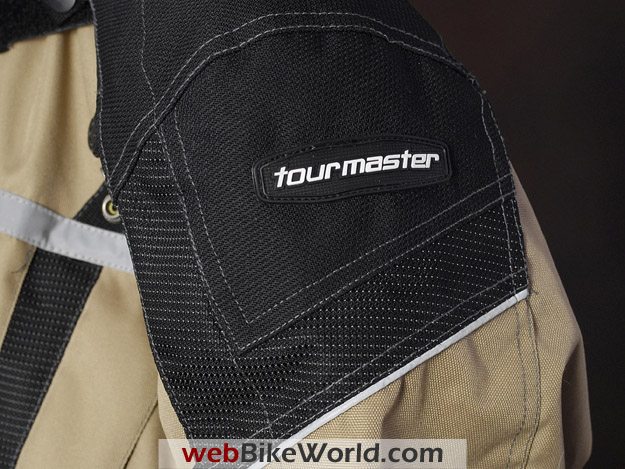
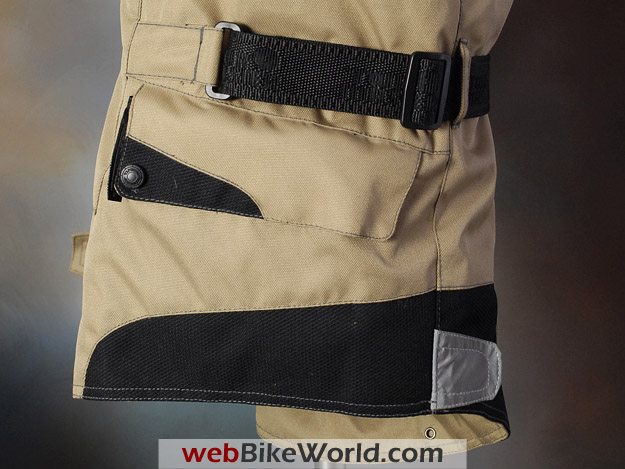
Armor, Protection and Padding
Tourmaster states that the Transition Series 2 uses CE-approved removable armor. The jacket has a small section of armor at the shoulder and a longer section in the elbow. The elbow armor is notched at the sides to help it flex.
The jacket also features a relatively thin back pad. The absence of more robust armor is probably due to pricing considerations, but the upside is that the slightly smaller and thinner armor makes the jacket more flexible and comfortable than it might be otherwise.
Although we haven’t tried it, it may be possible to replace the existing armor or back pad with something more robust. Alternatively, the armor can be removed and the owner can wear something like the Velocity Gear Juggernaut armored shirt (review) underneath, which would probably provide more protection than any combination of jacket armor that could be fitted anyway.
The elbows and shoulders on the Transition Series 2 jacket do include some added material (the black sections on the jacket in the photos) that appear to be heavier than the tan part of the jacket shell, and these probably offer some added abrasion resistance.
Reflectivity and Visibility
The jacket incorporates a highly reflective horizontal strip front and rear (see photos above right), and Tourmaster’s advertising for this jacket says that it also incorporates “Phoslite” reflective panels, which I think includes the material at the upper chest near the shoulders.
These are supposed to be reflective, but it’s been difficult to get this type of material to show off for the camera in any jacket we’ve tried that includes this material.
Pockets
The Transition Series 2 has a good supply of pockets, with two square pockets in the lower front acting as the main storage area. These are covered with a flap that uses both hook-and-loop and a rubber-covered metal snap, and they have a zipper underneath with a fabric zipper pull. These pockets feel like they are waterproof with a lining that is separate from the shell liner.
The vertical vents that are located in the center of the jacket, on either side of the central zipper were mentioned in the “Vents and Air Flow” section above. But these vents also hide a secret: they’re huge pockets!
The vent is opened with a zipper, and the vent opening can be kept open with a double section of hook-and-loop. Reach inside and the pockets are lined with mesh and they’re about 20 cm wide by 30 cm deep. Excellent!
The left sleeve has a handy little zipper covered pocket just above the cuff. Some spare toll booth change or an ID badge can be stored here. The pocket has a nice hidden surprise: an attached elastic lanyard with a spring-loaded hook on the end which can be attached to a set of keys or even a small change purse.
The jacket has a semi-hidden pocket at the lower back that opens with vertical zippers on either side. It’s a fairly large pocket at about 25 cm by 30 cm. The insulating liner can be stuffed in there if necessary, but it’s probably better suited for a windbreaker or wind-blocking vest. It will also easily hold a few bottles of water.
On the inside, the insulating liner features a square patch pocket on the right, inside the chest. This secures with hook-and-loop across the top. The left-hand side features two nice pockets; one for a cell phone and the other sized for a wallet. These also have a hook-and-loop flap with a nicely formed pull sewn to the front.
All three of these pockets are repeated on the inside of the jacket liner, meaning that whether the insulation is in or out, the owner has use of three nice internal pockets.
One more zippered pocket lives just inside the left placket. It appears to be waterproof and it’s the perfect place to stow a wallet.
Style and Comfort
The Transition Series 2 (was there a Series 1?) is also available in a nice color palette, ranging from the earthy tan/brown shown here that looks perfect over a modern Adventure Touring bike, to a high-vis yellow and the other color choices include yellow, silver, black or red. I looked at each of these colors at the 2009 Powersports Dealer Expo and the jacket looks very nice in any of the hues.
The jacket is designed very much in the Enduro style, probably more so than most other 3/4-length jackets I’ve seen. It looks good and it looks rugged and with a few sponsor patches sewn on here and there it might even pass for a Dakar rally jacket!
Conclusion
As long as the limitations are well considered, the Tourmaster Transition Series 2 is an excellent choice for a medium-weight 3/4-length jacket that will work in the majority of riding conditions that anyone but a hard-core Adventure Touring rider might encounter.
The Enduro styling, color choices, and excellent air flow are a bonus, and the price is definitely right.
| wBW Review: Tourmaster Transition Series 2 Jacket | |
|---|---|
| Manufacturer: Tourmaster | List Price (2009): $189.99 |
| Colors: Black, Red, Yellow, Tan, Silver or High-Visibility Yellow. | Made In: China |
| Sizes: XS to 4XL; M to 3XL Tall; Women’s XS to XL. | Review Date: April 2009 |
|
Note: Item was provided by a retailer, distributor or manufacturer with these Terms and Conditions.
|
|
Owner Comments and Feedback
See details on submitting comments.
From “E.H.” (5/09): “Thought I’d share my experiences with my Transition 2 jacket. I purchased it last summer for a trip with my wife from Wisconsin through Canada to New York and back. When we left in September there were several hurricanes down south and we caught the tails of two of them – one on the way out, and one on the way back. It rained on us literally every day for 10 days, from steady sprinkles to full downpours with driving wind and hail.
While the experience was miserable at the time, in hindsight the jacket did quite well as far as waterproofness. I don’t think it ever had a chance to dry out, but the only places I would get wet were where water would eventually wick in from the wrists or neck – and that was after several hours of riding in the rain. The outer shell of the jacket was completely soaked through, and got quite heavy, but the liner never got wet, and neither did I.
My only gripe with the jacket is the 3/4 length. On my touring bike (Suzuki V-Strom) it seems that it’s just the right length and sits at just the right position to catch wind and force air up into the jacket. That wouldn’t be a bad thing in the summer, but when it’s 45 degrees you sure notice it.
Pulling the tail down and sitting on it stops it, but the tail isn’t quite long enough and eventually works it’s way free to start grabbing air again. That might be a sizing issue with me though – I didn’t think I’d need the long at 6’0” tall, but maybe I have a long torso.
The venting is outstanding. I’ve had several long rides on it that start out pretty cool and eventually get quite warm. Opening up the vents makes warm (75+ F) temperatures tolerable even with the liner in. Though, once you stop or start riding slow, the liner has to come out.
The CE armor is comfortable and well placed and pretty much disappears when you put the jacket on. One thing you didn’t mention in your review is the adjustable sleeve volume. When you take out the liner, you can cinch down the arms to keep the sleeves snug. Not only does that prevent flapping, but it also helps keep the armor in place in a fall.
Overall, I give the jacket 5 stars and would buy another in a heartbeat, especially for the price. Don’t ask me about my Teknic Lightning “Waterproof” gloves though… unless you’d like to hear a lot of swearing.”
From “J.T.” (5/09): “I bought this jacket in October of last year, mostly because of the great price and a chance to try out a ¾ jacket since I switched from sportbikes to my GL1800. I’ve been getting more involved in (long distance) riding and noted that there was certain advantages to having a ¾ jacket vs. my Joe Rocket Alter Ego.
I ordered a brown Tourmaster Transition Series 2 jacket to try out and was pleased with it when it arrived. It contained one defect in a seam stitch in the left shoulder, but functioned fine.
Unfortunately I ended up testing the crash ability with in 2 weeks of ownership on my morning commute to work. I crested a hill to be greeted by 4 lanes of stopped traffic.
Post accident evaluation points to that I locked the front wheel up, although I really wasn’t in a panic braking situation, so I might have hit a patch of ice or fluid on the road just at the wrong moment. I came off the Wing at about 35-40 mph and slide on my left side for a bit.
The left shoulder got torn up pretty well and scratches along the left side. I suffered no injuries other then a sore hip, which went away within a week. I was impressed with this jacket and ordered an identical replacement the next day.”
Follow-Up: “I took some pictures, sorry for the delay I had a couple of trips since I sent you my post, the jacket did great on an 8 day Nova Scotia Trip and for my Minuteman 1000 rally this year. I actually say several LDRiders with the Tourmaster jacket.
My pleasure to help provide some real world impact testing:) webBikeWorld is such a great resource that every time someone on LDRider asks about a piece of gear or brand I refer them to your website.
That hole in right shoulder was the worst part (probably a little bigger then a quarter), but I expect that since it was a point load, i.e. I was sliding mostly on it, that would happen.
I actually had no pain in my upper back or shoulder, just my hip, which I think got twisted coming off the bike. The fabric in these new jackets seems to be thinner / lighter weight from the original generation of textile jackets 10+ years ago, but the armor is so much improved over the old 1/8 foam rubber.
Tourmaster jackets have a lighter weight fabric then the Joe Rocket jackets I have. The lighter weight makes them more comfortable to wear in hot weather which is a good thing. When I lived in Miami I often didn’t wear my leather or textile jackets because I would be a total sweat ball.
I wondered how an Aerostich suit would have fared in this event. I’ve seen some ‘stichs take a lot of damage and then the repair bill is often several hundred dollars. I figure if you spend that kind of money just to fix a suit, I would rather just buy gear that I consider sacrificial to the crash and thank my stars and go buy a new jacket that hasn’t been stressed in a slide or crash.”
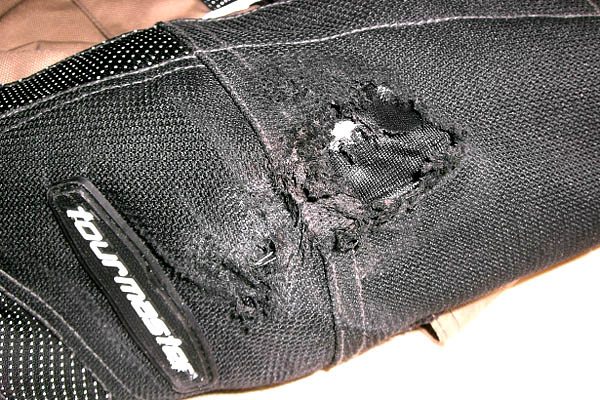

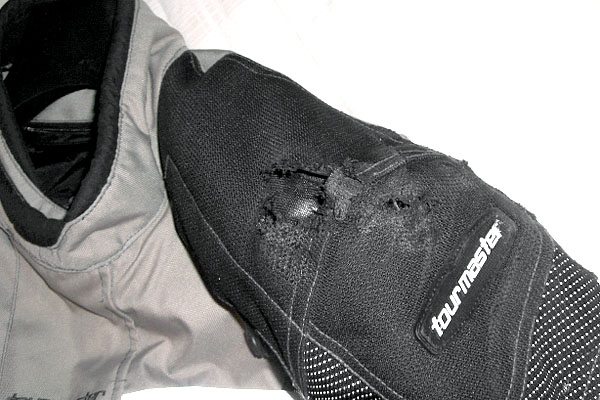

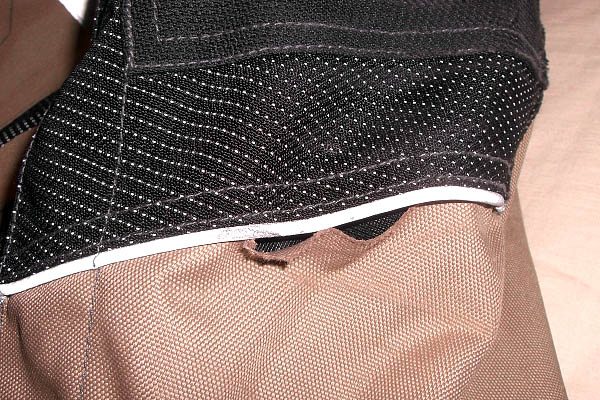

From “T.P.” (5/09): “One thing that readers should be aware of is that for taller riders needing the Tall size of the jacket, they are available in Black only. Tall guys get NO color choice.
An alternative 3/4 jacket to look at in the Tourmaster line is the Saber 2. It sells for about $130 with a few less features but has a better fit for tall riders. The XXL standard length size fit my 36″ long sleeve length arms just fine and I can get the jacket in a color other than black.
One big plus for me was the inclusion of hand warmer pockets on the Saber 2 that are missing on the Transition Series 2 jacket (a deal breaker for me). I need to put my hands somewhere when I’m off the bike.”
From “D.M.” (4/09): “I bought this jacket at the end of summer last year and have been wearing it ever since. I’m a Michigan transplant living in Georgia, and I rode my FJR all winter, as long as the sun was shining.
My coldest day riding was 23 degrees. I had on my jacket, it’s liner and a flannel shirt and I was surprisingly comfortable. I rode many days when the temps were in the 30’s and never once did I get cold. Maybe growing up playing in the snow gave me more cold tolerance, but I’ve found this jacket to be exceptionally windproof and warm.
Appreciate your website, lots of good info.”
From “M.C.” (4/09): “While I have not touched a Series 2 jacket, I bought one of the original Transition jackets when they were first introduced. At first I was quite pleased with it, although the indifferent stitching did not impress me.
It was windproof, water-proof in a couple of deluges in which I got caught, and quite snug. It was reasonably warm down to about 40°F when riding at 70 mph, and of course, the pockets were a great selling point. I can tell you the retroreflective tape Tourmaster uses worked quite well. In daylight, the tape strips could be almost blinding and in poor visibility conditions, my wife and a few other riders told me they had no problem spotting me in traffic.
Although I don’t worship at the altar of high-viz clothing, I also don’t want to be the Invisible Man, and on the grey fabric of my jacket, the retroreflective strips were much needed to keep the jacket from being urban camouflage.
In a few short months, though, it became quite clear that the materials used were even shoddier than the stitching. I found small holes forming all over the “Carbolex” shell after less than five months of use, particularly where there were pleats in the fabric but also on the flat expanses.
If I still had the jacket, I’d be happy to take photos for you to see for yourself. I later found on ADVRider.Com that other Transition owners were having similar issues and that the jacket often did not fare well at all in even the slowest speed falls. The armor, I found, had a pronounced tendency to shift, which would not have been a big deal if Tourmaster had provided better precision in adjusting the fit by using cinching straps rather than button snaps.
From the pics of the Series 2, the biggest difference seems to be the addition of the two vents flanking the main zipper, which I can vouch were needed because the first series jacket had terrible ventilation, although I’m sure the growing number of perforations would have helped eventually. Speaking of zippers, that was the last straw for me with the Transition. The zipper seemed to slip a tooth and bound so tightly I broke the zipper trying to work it free.
I looked at some of the Cortech jackets to replace it, but they were no better made than the rest of the Tourmaster line. I wound up buying a Teknic Freeway jacket which has been a night-and-day difference except for not having as many reflective bits on it.
It is much better insulated, protects the neck better against wind chill, does not develop noticeable cold spots, has much better venting with or without the lining in place, does not ride up at high speeds, and can be cinched up more tightly to keep the armor in better position.
It is also hasn’t fallen apart or shown noticeable wear despite near daily use in the last six months. The Transition may be half the retail cost, but in my opinion, it represents false economy.”
From “G.T.” (4/09): “I own one of the first generation Transition Jackets, and except for a few quality control issues (broken neck snap and some sloppy stitching), this is my most versatile jacket for almost any conditions.
I own about 15 jackets from various manufacturers and most are too bulky, don’t vent well, or are just not comfortable. All one needs to make this the ideal jacket for all weather touring is a heated liner (I have a Gerbing) and a lightweight windshirt. If it rains, I wear a Joe Rocket waterproof jacket liner under the jacket. This is my jacket of choice for any long trip.
After riding for over 46 years, I have found that proper layering from base garments to the outer shell is the key to being comfortable when encountering a wide range of conditions. I highly recommend a fine wool base layer (I really like Smartwool products, as they do not itch) because nothing helps to conserve body heat like wool when one is soaked to the bone.
In hot weather, synthetics are o.k. as long as they have an open weave fabric, but when it is really hot, I prefer cotton because I can soak the shirt in water and wear it under my Transition jacket and stay very comfortable in over 100 degree temperatures.
Thanks for the excellent reviews on a wide variety of motorcycle related products. I have purchased several products based on your in-depth and unbiased reviews.”
From “D.S.” (4/09): “I recently added the hi-viz version of this jacket to my collection. My only complaint is the way some of the Velcro is stitched on. After a year or two of use, the “loop” side of Velcro tends to wear out, whereas the “hook” part tends to last forever.
This jacket has the “hook” portion on the tabs at neck and sleeves; to replace the “loop” will require stitching through the shell of the jacket instead of the tabs, further decreasing its all weather ability. Other than that complaint, I really like this jacket!”
From “R.D.” (4/09): “I’m glad to hear unless you pay big bucks you can’t buy a real all weather MC jacket. My first textile 3/4 jacket was the Moto Line (Difi) Canyon jacket with some venting. Like you, I’ll take a good venting 3/4 jacket any time over a waterproof.
I still have this jacket and when new 10? years ago ($200) it was state of the art if not a top of the line Aerostich. It served me well but it’s ventilation was inadequate for triple digit riding days.
But a few years ago I got an Israeli 3/4 length jacket for so little $ you wouldn’t believe me…….. that is the best ventilated textile jacket I’ve ever owned. Even in the hottest weather I’m relatively comfortable in it like never before.
Its only all weather drawback is it’s primo ventilation (zippers full length of arms) are not waterproof. It has zipper vents on the back and front of shoulders too. So now I have a one-piece rainsuit for that real rain.
This Israeli jacket’s outside fabric is somehow H2O proof and it’s neck protector is soft and reaches my full face helmets for complete neck, chin protection. Anyway, since I’ll never pay an Aerostich price, I’ll keep an eye on Tourmaster jackets if and when I need another.
I do have the Tourmaster tri-tank bag set and couldn’t be happier with it for all my 4 bikes. I/we are sport/tourers.”


